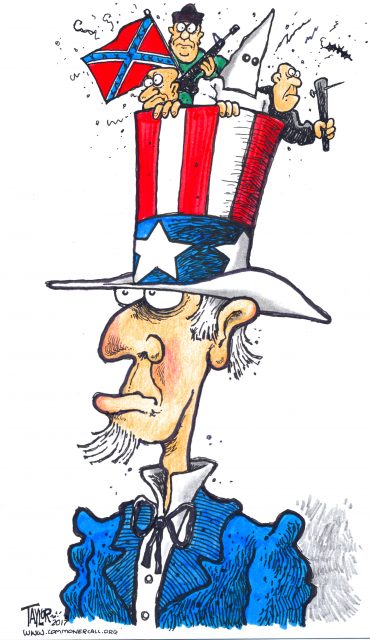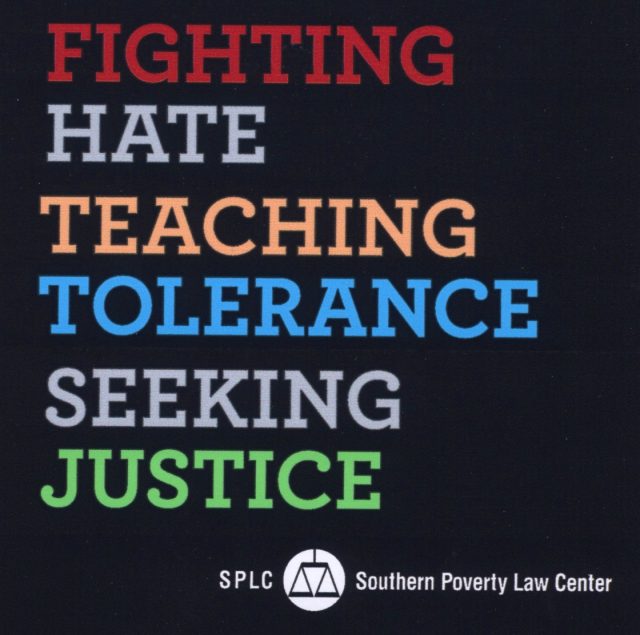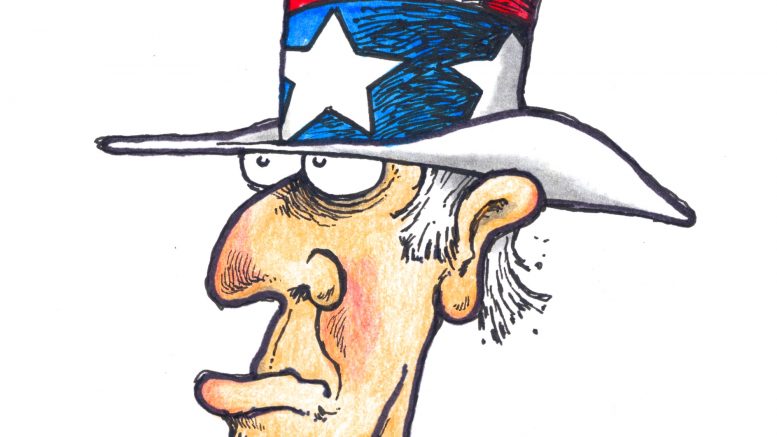
By Arie Perliger
The Conversation (5/28/17)
The murder in College Park, Maryland of Richard Collins III, an African-American student who had recently been commissioned as a second lieutenant in the U.S. Army and was days away from his graduation from Bowie State University, underscores the violence of America’s far-right wing. Sean Urbanski, the University of Maryland student who allegedly stabbed Collins to death, belongs to a racist Facebook group called Alt-Reich: Nation.
It makes sense that the FBI is helping the police investigate this incident as a suspected hate crime. But my 15 years experience of studying violent extremism in Western societies has taught me that dealing effectively with far-right violence requires something more: treating its manifestations as domestic terrorism.
While attacks such as the recent suicide bombing in Manchester that left 22 people dead and several dozen injured will probably continue to garner more headlines, this growing domestic menace deserves more attention than it’s getting.
Domestic terrorism
Terrorism is a form of psychological warfare. Most terrorist groups lack the resources, expertise and manpower to defeat state actors. Instead, they promote their agenda through violence that shapes perceptions of political and social issues.
Collins’ murder, if it was motivated by racist sentiments, should be treated as an act of domestic terrorism, which I define here as the use of violence in a political and social context that aims to send a message to a broader target audience. Like lynching, cross-burning and vandalizing religious sites, incidents of this kind deliberately aim to terrorize people of color and non-Christians.
Despite an uptick in far-right violence and the Trump administration’s plan to increase the Department of Homeland Security budget the White House wants to cut spending for programs that fight non-Muslim domestic terrorism.
I consider domestic terrorism a more significant threat than the foreign-masterminded variety in part because it is more common in terms of the number of attacks on U.S. soil. For example, my report published by the Combating Terrorism Center at West Point identified hundreds of domestic terror incidents per year between 2008 and 2012.
Another report initially published in 2014 by New America Foundation on domestic incidents of extremist violence shows that excluding the Orlando nightclub massacre, between 2002-2016, far-right affiliated perpetrators conducted 18 attacks that killed 48 people in the United States, while terrorists motivated by al-Qaida’s or the Islamic State’s ideology killed 45 people in nine attacks.
The Orlando mass shooting, given its mix of apparent motives, is hard to categorize.
A spontaneous appearance
In briefings with law enforcement and policymakers, I have sometimes encountered a tendency to see U.S. right-wing extremists as a monolith. But traditional Ku Klux Klan chapters operate differently than skinhead groups, as do anti-government “patriot” and militia groups and anti-abortion extremists. Christian Identity groups, which believe Anglo-Saxons and other people of Northern European descent are a chosen people, are distinct too.
Certainly, there is some overlap. But these groups also differ significantly in terms of their methods of violence, recruitment styles and ideologies. Across the board, undermining the threat they pose requires a more sophisticated approach than investigating their criminal acts as suspected hate crimes.
In an ongoing study I’m conducting at the University of Massachusetts Lowell with several students, we have determined that, as apparently occurred with Collins’ recent murder in Maryland, many attacks inspired by racist or xenophobic sentiments may appear spontaneous. That is, no one plans them in advance or targets the victim ahead of time. Instead, chance encounters that enrage the perpetrators trigger these incidents.
Sporadic attacks with high numbers of casualties that are plotted in advance, such as Dylann Roof’s murder of nine African-Americans in a Charleston, South Carolina church, are always big news. More typical incidents of far-right violence tend to draw less attention.
The fatal stabbing of Taliesin Myrddin Namkai Meche and Ricky John Best aboard a train in Portland, Oregon on May 26 seems to be emerging as an exception. The alleged killer of these two white men, Jeremy Joseph Christian, attacked them with a knife after they stood up to him for haranguing two young women who appeared to be Muslim, police said. A third injured passenger is expected to survive. Much of the media coverage is focused on Christian’s violent and racist background.
Given the spontaneous nature of so much far-right violence, U.S. counterterrorism policies should, in my view, target the dissemination of white supremacist ideology, rather than just identifying planned attacks and monitoring established white supremacy groups.
An iceberg theory
The number of violent attacks on U.S. soil inspired by far-right ideology has spiked since the beginning of this century, rising from a yearly avarage of 70 attacks in the 1990s to a yearly avarage of more than 300 since 2001. These incidents have grown even more common since President Donald Trump’s election.
The Southern Poverty Law Center, a nonprofit that researches U.S. extremism, reported 900 bias-related incidents against minorities in the first 10 days after Trump’s election – compared to several dozen in a normal week – and the group found that many of the harassers invoked the then-president-elect’s name. Similarly, the Anti-Defamation League, a nonprofit that tracks anti-Semitism, recorded an 86 percent rise in anti-Semitic incidents in the first three months of 2017.
Beyond the terror that victimized communities are experiencing, I would argue that this trend reflects a deeper social change in American society.
The iceberg model of political extremism, initially developed by Ehud Shprinzak, an Israeli political scientist, can illuminate these dynamics.
Murders and other violent attacks perpetrated by U.S. far-right extremists compose the visible tip of an iceberg. The rest of this iceberg is under water and out of sight. It includes hundreds of attacks every year that damage property and intimidate communities, such as the recent attempted burning of an African-American family’s garage in Schodack, New York. The garage was also defaced with racist graffiti.
Data my team collected at the Combating Terrorism Center at West Point show that the significant growth in far-right violence in recent years is happening at the base of the iceberg. While the main reasons for that are still not clear, it is important to remember that changes in societal norms are usually reflected in behavioral changes. Hence, it is more than reasonable to suspect that extremist individuals engage in such activities because they sense that their views are enjoying growing social legitimacy and acceptance, which is emboldening them to act on their bigotry.
Budget cuts threaten public safety
Despite an uptick in far-right violence and the Trump administration’s plan to increase the Department of Homeland Security budget by 6.7 percent to US$44.1 billion in 2018, the White House wants to cut spending for programs that fight non-Muslim domestic terrorism.
The federal government has also frozen $10 million in grants aimed at countering domestic violent extremism. This approach is bound to weaken the authorities’ power to monitor far-right groups, undercutting public safety.
How many more innocent people like Richard Collins III – and Taliesin Myrddin Namkai Meche and Ricky John Best – have to die before the U.S. government starts taking the threat posed by violent white supremacists more seriously?
(Arie Perliger has received funding from the Combating Terrorism Center at the United States Military Academy at West Point.)
(Republish The Conversation articles for free, online or in print, under Creative Commons license.)
Commoner Call cartoon by Mark L. Taylor, 2017. Open source and free to use with link to www.thecommonercall.org )
*****
‘Legitimized in their hatred’: A Memorial Day Weekend Of Violence In Trump’s Dark America
By Sam Levin
The Guardian (5/31/17)
Anthony Hammond was screaming racial slurs in the parking lot of a California apartment complex before he pulled out a machete and stabbed an African American man, according to police.
The horrific Saturday night attack – which led to hate crime, assault and mayhem charges against the 34-year-old white suspect – received very little attention in US media during the Memorial Day holiday. Also lost in weekend news was the case of a white man in a pickup truck who police say intentionally ran over and killed a 20-year-old Native American man.
A brutal double murder in Portland, a stabbing in California, and the hit-and-run death of a Native American man – all within a few days – are dark signs
The lack of press for both racially charged attacks could be due to the fact that the nation was still reeling from news of a double murder in Portland, Oregon, in which a man stabbed three people who were reportedly trying to stop a racist attack on two young Muslim girls.
The series of attacks in one weekend, along with a threat from a Republican lawmaker to shoot his colleague amid an immigration battle, offer a stark portrait of the racial violence and hate speech in America that activists say have grown since Donald Trump’s election. From Washington state to Texas, the holiday meant to honor fallen soldiers was marred by gruesome assaults during a presidency that critics say has normalized white supremacy and emboldened bigots.
“Trump supporters are now feeling legitimized in their hatred and wanting to act out further,” said Ryan Lenz, senior investigative writer with the Southern Poverty Law Center (SPLC), which has tracked a rise in hate groups and incidents during Trump’s campaign and since his inauguration. “It speaks to a climate of hate and intolerance across the country. These three are not isolated.” …
*****
Making America Meaner & Nastier
By Robert Reich
RobertReich.org (5/29/17)
Last Wednesday, on the eve of his election to the House of Representatives, Montana Republican Greg Gianforte beat up Ben Jacobs, a reporter for the “Guardian” newspaper.
What prompted the violence? Jacobs had asked Gianforte for his reaction to the Congressional Budget Office’s report showing that the House Republican substitute for the Affordable Care Act would result in 23 million Americans losing their health insurance.
Then, in the words of a Fox News team who witnessed the brutal attack: “Gianforte grabbed Jacobs by the neck with both hands and slammed him into the ground behind him. … Gianforte then began punching the reporter. As Gianforte moved on top of Jacobs, he began yelling something to the effect of, ‘I’m sick and tired of this!’ Jacobs scrambled to his knees and said something about his glasses being broken…. To be clear, at no point did any of us who witnessed this assault see Jacobs show any form of physical aggression toward Gianforte, who left the area after giving statements to local sheriff’s deputies.”
After the attack, Jacobs was evaluated in an ambulance at the scene and taken to Bozeman Health Deaconess Hospital. Several hours later he left the hospital wearing a sling around his arm. Gianforte was charged with misdemeanor assault.
Donald Trump’s reaction? He praised Greg Gianforte’s election as a “great win in Montana.”
More generally and menacingly, Trump has licensed the dark side of the American psyche. His hatefulness and vindictiveness have normalized a new meanness in America.
For years, conservatives warned that liberals were “defining deviancy down” by tolerating bad social behavior.
Donald Trump is actively defining deviancy down in American politics. He’s also making America meaner.
Last year, Trump said of a protester at one of his campaign rallies: “I’d like to punch him in the face.” He added “in the old days, protesters would be carried out on stretchers.“
In a different era, when decency was the norm, the members of the U.S. House of Representatives would not seat a thug like Gianforte in the chamber. But House Republicans seem eager to have another kindred spirit.
Charlie Sykes, a conservative former talk-show host in Wisconsin, says “every time something like Montana happens, Republicans … normalize and accept previously unacceptable behavior.”
Gianforte’s attack on Jacobs was shameful enough. Almost as shameful was Gianforte’s press release about what occurred, which blamed Jacobs. “It’s unfortunate that this aggressive behavior from a liberal journalist created this scene at our campaign volunteer BBQ.”
It was a blatant lie, as evinced by the Fox News team and the charge against Gianforte. But under Trump, blatant lying is the new normal. And a “liberal journalist” is the enemy.
Kathleen Hall Jamieson, a professor at the University of Pennsylvania’s Annenberg School for Communication, says Donald Trump “has contributed to a climate of discourse consistent with assaulting a reporter for asking an inconvenient question.”
It used to be that candidates and elected officials were supposed to answer reporters’ questions. We thought democracy depended on it. But we’re now in the era of Donald Trump, who calls the press the “enemy of the American people.”
In America, candidates or officials didn’t beat up reporters who posed questions they didn’t like. That kind of thing occurred in dictatorships.
More generally and menacingly, Trump has licensed the dark side of the American psyche. His hatefulness and vindictiveness have normalized a new meanness in America.
Since Trump came on the scene, hate crimes have soared. America has become even more polarized. Average Americans say and do things to people they disagree with that in a different time would have been unthinkable.
“I’d submit that the president has unearthed some demons,” says Rep. Mark Sanford, a Republican Representative from South Carolina. “I’ve talked to a number of people about it back home. They say, ‘Well, look, if the president can say whatever, why can’t I say whatever?’ He’s given them license.”
The new meanness is also finding its way into public policy, where Trump wants unprecedented cuts in Medicaid, Social Security disability, and food stamps, and to shove 23 million Americans off health insurance – all so the rich and corporations can get big tax cuts.
I recall a time in America where this kind of proposal would be considered an affront to decency. Now it’s the baseline for negotiations.
A president contributes to the norms of our society. He sets the moral tone. Trump is setting them at a new low.
*****
As Trump’s White Christian Voter Base Shrinks The Question Becomes What Will Replace It?
By Steven Rosenfeold
AlterNet (5/26/17)
Robert P. Jones is the founding CEO of the Public Religion Research Institute (PRRI). Jones has earned a reputation as a sterling pollster of religious trends in America and how they affect politics, elections and the social fabric. In 2016, his latest book, The End of White Christian America, was praised for its insights into the fears of white Christians and they flocked to Donald Trump. Alternet’s Steven Rosenfeld asked Jones what he sees since the election. (Read a book excerpt.) …
*****

Support The Southern Poverty Law Center’s Work To Expose & Counter American Right Wing Domestic Terrorism
The SPLC is dedicated to fighting hate and bigotry and to seeking justice for the most vulnerable members of our society. Using litigation, education, and other forms of advocacy, the SPLC works toward the day when the ideals of equal justice and equal opportunity will be a reality.
Link to SPLC web site HERE.

